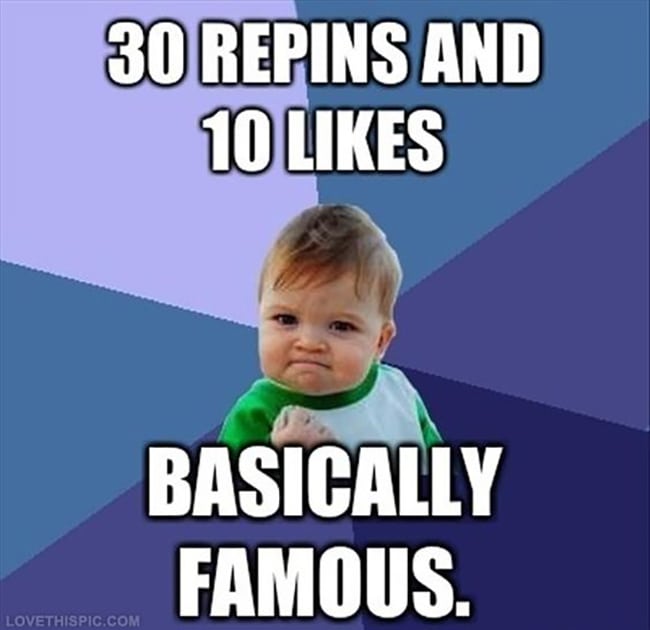
What’s the first thing a company should do before getting into content marketing?
While opinions may vary, I’d say that analyzing other successful content marketers and their approach is a good start.
Before Twitter shut off the API that allowed people to easily display tweet counts, I went on a data gathering spree…
During the month of October 2015, I downloaded social share counts from top blogs. Here are a few things I learned when analyzing their most shared posts.
1. Popular blogs have underestimated the power of visual content — especially on Pinterest
We all love consuming content with pretty visuals that help illustrate the point of a post. But when it comes to actually publishing our own visual content, content marketers can be quick to make excuses:
- Increased content production costs
- Longer production time
- Lack of a visual content strategy

With all these obstacles in sight, why should marketers put in the time and effort to produce more visual content?
For starters, visual content has been shown to do well on social media. According to an article by Buffer, content with images gets 94% more views and receives 150% more retweets.
This is especially powerful on Pinterest where popular pins can get shared and re-pinned for months after they were first pinned.
Take Content Marketing Institute for example. Their most shared post has over 40,000 total shares — more than quadruple the shares of even their second-most shared post.
Guess where more than 90% of those shares came from?
Pinterest!

Content Marketing Institute doesn’t typically focus heavily on visual content — blog posts don’t have pin-able featured images or an easy-to-find Pinterest share button. Still, this beautiful piece of visual content compelled readers to pin it, effectively making this post into the most shared post on the site to date.
Similarly, the top two shared posts on the Unbounce blog contain infographics and have heavy social sharing coming from Pinterest.
Unbounce’s most shared article: Checklist: 12 Things You *Must* do After Writing a New Blog Post [with Infographic]
- Pinterest shares: 11,723
- Total shares: 13,391
Second-most shared post: The Noob Guide to Online Marketing [INFOGRAPHIC]
- Pinterest Shares: 4,808
- Total Shares: 12,642
The takeaway here?
Visual content may be more work, but don’t underestimate its potential when it comes to putting your content (and your brand) in front of a broader audience.
2. Despite the hate, expert roundups are highly effective
Expert roundups have a bit of a bad rap.
SEO pundit Jacob King recently ranted about how these posts are often “desperate attempts to get links and social shares,” often incorporating quotes from online marketers that people have never heard of. Jacob’s rant was upvoted to the top of Inbound.org for several days.
Well, there’s a reason that so many newbie bloggers are jumping on the “expert roundup” train: when executed properly, they can result in a ton of social shares.
Take Social Media Examiner for example — one of the most popular blogs in the online marketing sphere. Three of its top five most shared posts are expert roundups:
Note: The total shares represent the summation of share counts from Facebook, Twitter, Google Plus, LinkedIn and Pinterest.

So get your lasso ready, but please be sure to reach out to actual experts who can teach your readers a new thing (or two).
3. Not all popular content is optimized for SEO
A lot of businesses looking to get into content marketing are obsessed with SEO. Their hope is that they can create a ton of optimized content to drive traffic to their sites (and hopefully drive a ton of conversions, too).
However, search engines are only one of many sources of traffic, and not all popular content is optimized for it.
In fact, if you want something to go viral on social media, sometimes it’s better to create a title that is compelling and gets attention (rather than one that is clearly targeting a keyword that you want to rank for).
Help Scout Blog’s most shared post “Silence Is a Noxious Gas” has 9,929 social shares — and judging by the more “clever” title, SEO isn’t their primary goal.
In fact, if you look at Help Scout’s most shared articles, you’ll see that they’re likely aiming for a mix of SEO-optimized articles and catchy, share-worthy content:
While search engines are an important consideration, you don’t have to optimize everything for SEO. For every post you write, decide whether you want to rank or get shares, and then optimize for that singular goal.
4. People love a little controversy
I’ve pitched a variety of guest post ideas to different blogs. One interesting discovery is that many established blogs are afraid of controversial or speculative content.
However, my research showed that controversy and different perspectives can make content stand out and get noticed.

In the most shared article on the WordStream blog, “Goodbye, Google+: Social Network Broken Into Streams and Photos Products,” Larry Kim declares the death of Google+.
While predicting the death of Google+ was speculative, Larry had some pretty persuasive arguments to back up his opinion. The result?
The article fueled a heated discussion among the online marketing community — and it got shared far and wide.
5. Broadly targeted articles can significantly increase social reach
Properly defining the scope of their content is a challenge that content marketers everywhere face.
Should articles be narrow in focus and catered to a very specific target market? In this post on Quick Sprout (see Lesson #4), Neil Patel explains that narrowing the scope of their content to target e-commerce and SaaS companies provided more and better leads for their sales team.
However, other prominent content marketers have achieved success by doing the opposite: publishing top-of-the-funnel content that is broader in scope and more likely to resonate with a larger audience. Have a look at the top five most shared posts on the Buffer blog:
The most shared post is about music and doesn’t have much to do with social media. The “Why Facebook is Blue” post by Leo Widrich has some insights that are applicable to social media marketers, but approaches the topic from an angle that is relatable to the general public.
While these posts may not convert customers as well as posts that are more focused on social media marketing, they do massively increase social reach and are great for branding and awareness.
Most content marketers focus on writing targeted articles that zero in on the interests and pain points of their prospects. But occasionally, a broadly targeted article can be beneficial, especially if it has viral potential.
6. List posts are still popular
Popular blogs in the online marketing niche love data-driven content and case studies. List posts, on the other hand, don’t get as much appreciation from editors since they’re much easier to create and generally less authoritative and actionable.

In fact, some sites that accept guest contributions specifically state that they don’t want people to submit list posts.
Still, the proof is in the pudding. When they’re done right, list posts often result in a high number of social shares.
Post Planner has seen a lot of success with their list posts. Just take a look at their top five shared blog articles:
So before you dismiss a list post as too “fluffy” for your readers, consider that it just might be what they’re looking for (or at least looking to Tweet about).
Key lessons…
Phew — that was a lot of data to process. Let’s recap the key takeaways.
1. Put more time into your visual content marketing strategy
While visuals and infographics increase the time and cost of content production, they allow content to get shared more. Even content marketers that aren’t focused on Pinterest have seen some nice gains from that social network.
2. Expert roundups are effective
Although expert roundups are not popular with some content marketers, they are still highly effective if executed well. Several of Social Media Examiner’s top posts are expert roundups.
3. Not all posts have to be optimized for search engines
While SEO is an important consideration and should be applied to some content, not everything needs to be optimized for search engines. In fact, sometimes ignoring keywords and creating a compelling headline can incentivize more readers to click that share button.
4. Readers love speculation and controversy
Many established content marketers stay away from speculative or controversial content, but it’s a strategy that can result in significant social sharing and traffic.
5. Broadly targeted articles can increase reach
Many content marketers define their niche narrowly to attract a high-converting audience. But broadly targeted articles are good for branding and can expand social reach significantly. Incorporating at least a few broadly targeted articles could be helpful if one of your content marketing goals is to increase brand awareness.
6. List posts still work
Some blogs stay away from list posts and favor case studies and data-driven content. However, list posts are still shown to be popular on social media — consider mixing a few into your editorial calendar.

